When Drug Labels Miss the Twist: The regulatory bind spot
“When chemistry tells two stories, the label should tell both” Drug labels tell us what’s inside — but not always how the molecule twists. And sometimes, that subtle twist changes everything: how a drug acts, how it’s regulated, and even whether it’s safe or addictive. Chirality — the property of handedness in molecules — has always shaped pharmacology. One mirror image of a molecule (an enantiomer) can save lives, while its twin may do little …
When Drug Labels Miss the Twist: The regulatory bind spot Read More »


